Amphibolic pathways - Study guides, Class notes & Summaries
Looking for the best study guides, study notes and summaries about Amphibolic pathways? On this page you'll find 60 study documents about Amphibolic pathways.
Page 4 out of 60 results
Sort by
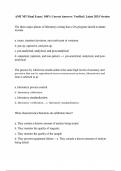
-
AMT MT Final Exam | 100% Correct Answers | Verified | Latest 2024 Version
- Exam (elaborations) • 176 pages • 2024
-
- $14.00
- + learn more
The three major phases of laboratory testing that a QA program should evaluate include a. mean, standard deviation, and coefficient of variation. b. pre-op, operative, and post-op. c. pre-analytical, analytical, and post-analytical. d. outpatient, inpatient, and non-patient. - c. pre-analytical, analytical, and post-analytical. The process by which test results achieve the same high levels of accuracy and precision that can be reproduced across measurement systems, laboratories and time is ...
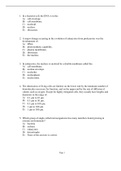
-
TESTBANK for Lehninger Principles of Biochemistry 7th Edition, Nelson
- Other • 647 pages • 2022
-
- $13.99
- 1x sold
- + learn more
Lehninger Principles of Biochemistry 7th Edition Nelson testbank 1. In a bacterial cell, the DNA is in the: A) cell envelope. B) cell membrane. C) nucleoid. D) nucleus. E) ribosomes. 2. A major change occurring in the evolution of eukaryotes from prokaryotes was the development of: A) DNA. B) photosynthetic capability. C) plasma membranes. D) ribosomes. E) the nucleus. 3. In eukaryotes, the nucleus is enclosed by a double membrane called the: A) cell membrane. B) nuclear envelo...
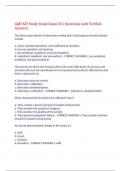
-
AMT MT Study Guide Exam 551 Questions with Verified Answers,100% CORRECT
- Exam (elaborations) • 130 pages • 2024
-
- $13.99
- + learn more
AMT MT Study Guide Exam 551 Questions with Verified Answers The three major phases of laboratory testing that a QA program should evaluate include a. mean, standard deviation, and coefficient of variation. b. pre-op, operative, and post-op. c. pre-analytical, analytical, and post-analytical. d. outpatient, inpatient, and non-patient. - CORRECT ANSWER c. pre-analytical, analytical, and post-analytical. The process by which test results achieve the same high levels of accuracy and prec...
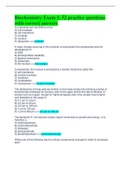
-
Biochemistry Exam 1, 52 practice questions with correct answers. Questions with accurate answers, Garded A
- Exam (elaborations) • 10 pages • 2023
-
- $9.49
- + learn more
Biochemistry Exam 1, 52 practice questions with correct answers. Questions with accurate answers, Garded A Document Content and Description Below Biochemistry Exam 1, 52 practice questions with correct answers In a bacterial cell, the DNA is in the: A) cell envelope. B) cell membrane. C) nucleoid. D) nucleus. E) ribosomes. >>>nucleoid A major change occurring in the evolution of eukaryotes from prokaryotes was the development of: A) DNA. B) photosynthetic capability. C) plasma membran...
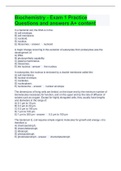
-
Biochemistry - Exam 1 Practice Questions and answers A+ content
- Exam (elaborations) • 10 pages • 2023
- Available in package deal
-
- $18.49
- + learn more
In a bacterial cell, the DNA is in the: A) cell envelope. B) cell membrane. C) nucleoid. D) nucleus. E) ribosomes. nucleoid A major change occurring in the evolution of eukaryotes from prokaryotes was the development of: A) DNA. B) photosynthetic capability. C) plasma membranes. D) ribosomes. E) the nucleus the nucleus In eukaryotes, the nucleus is enclosed by a double membrane called the: A) cell membrane. B) nuclear envelope. C) nucleolus. D) nucleoplasm. E) nucl...
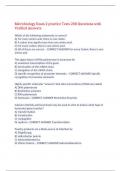
-
Microbiology Exam 2 practice Tests 208 Questions with Verified Answers,100% CORRECT
- Exam (elaborations) • 42 pages • 2024
-
- $12.99
- + learn more
Microbiology Exam 2 practice Tests 208 Questions with Verified Answers Which of the following statements is correct? A) For every amino acid, there is one codon. B) A codon may signify more than one amino acid. C) For every codon, there is one amino acid. D) All of these are correct. - CORRECT ANSWER For every Codon, there is one amino acid The sigma factor of RNA polymerase is necessary for A) maximum transcription of the gene. B) termination of the mRNA chain. C) elongation...
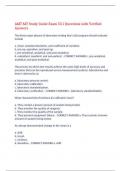
-
AMT MT Study Guide Exam 551 Questions with Verified Answers,100% CORRECT
- Exam (elaborations) • 130 pages • 2024
-
- $13.49
- + learn more
AMT MT Study Guide Exam 551 Questions with Verified Answers The three major phases of laboratory testing that a QA program should evaluate include a. mean, standard deviation, and coefficient of variation. b. pre-op, operative, and post-op. c. pre-analytical, analytical, and post-analytical. d. outpatient, inpatient, and non-patient. - CORRECT ANSWER c. pre-analytical, analytical, and post-analytical. The process by which test results achieve the same high levels of accuracy and prec...
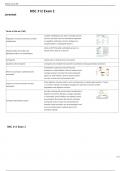
-
BISC 312 Exam 2 Terms in this set (163) Regulation of enzyme activity by covalent modification covalent modifications are often reversible and are done by enzymes which are themselves subjected to regulation. Extremely common strategy (ex. phosphor
- Exam (elaborations) • 10 pages • 2024
- Available in package deal
-
- $8.99
- + learn more
BISC 312 Exam 2 Terms in this set (163) Regulation of enzyme activity by covalent modification covalent modifications are often reversible and are done by enzymes which are themselves subjected to regulation. Extremely common strategy (ex. phosphorylation or dephosphorylation) phosphorylation by kinases and dephosphorylation by phosphatases utilize an ATP that adds a phosphate group to a specific amino acid on an enzyme zymogems proenzymes or inactive forms of enzymes regulati...

-
Biochemistry - Exam 1 Practice Questions and Answers 2022
- Exam (elaborations) • 10 pages • 2022
- Available in package deal
-
- $13.99
- + learn more
In a bacterial cell, the DNA is in the: A) cell envelope. B) cell membrane. C) nucleoid. D) nucleus. E) ribosomes. nucleoid A major change occurring in the evolution of eukaryotes from prokaryotes was the development of: A) DNA. B) photosynthetic capability. C) plasma membranes. D) ribosomes. E) the nucleus the nucleus 00:34 01:10 In eukaryotes, the nucleus is enclosed by a double membrane called the: A) cell membrane. B) nuclear envelope. C) nucleolus. D) nuc...

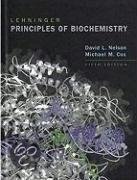
-
TestBank Lehninger Principles of Biochemistry 7e Nelson TB
- Exam (elaborations) • 560 pages • 2022
-
- $16.00
- + learn more
TestBank Lehninger Principles of Biochemistry 7e Nelson TB TestBank Lehninger Principles of Biochemistry 7e Nelson TBPage 1 1. In a bacterial cell, the DNA is in the: A) cell envelope. B) cell membrane. C) nucleoid. D) nucleus. E) ribosomes. 2. A major change occurring in the evolution of eukaryotes from prokaryotes was the development of: A) DNA. B) photosynthetic capability. C) plasma membranes. D) ribosomes. E) the nucleus. 3. In eukaryotes, the nucleus is enclosed by a d...

Study stress? For sellers on Stuvia, these are actually golden times. KA-CHING! Earn from your study resources too and start uploading now. Discover all about earning on Stuvia


